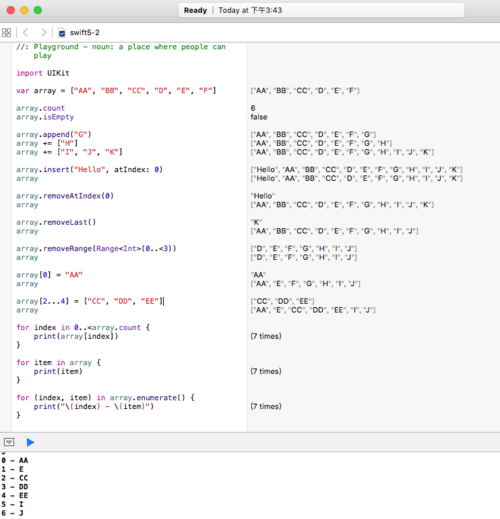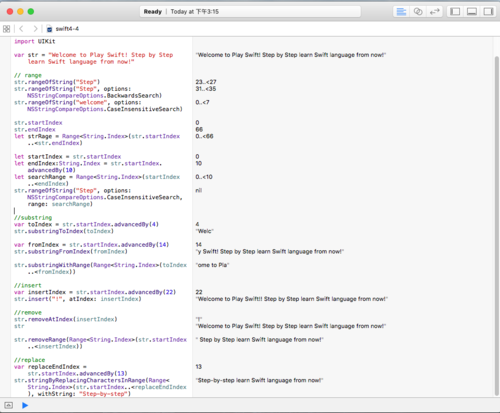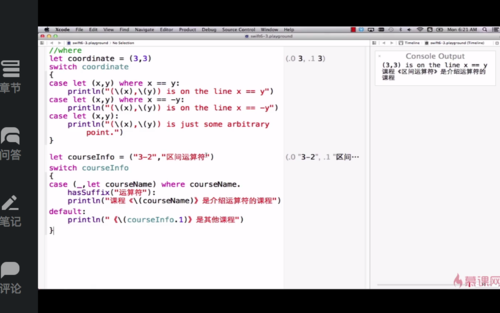-
区间[a,b]在swift语言中的表达式是a...b
区间[a,b)在swift语言中的表达式是a..<b
那么我猜(a,b]=a>..b
可是(a,b)怎么表示呢?
查看全部 -
question?answer1:answer2,基础运算的意思是
判断“question的Bool值”,若返回“true”则执行“answer1”,若返回“false”则执行“answer2”
其实际是对if else语句的省略使用,相当于
if question
{
answer1
}
else
{
answer2
}
查看全部 -
比较运算符的解释:
==,比较符号左右两侧的值是否相等,若相等返回Bool值“true”
!=,比较符号左右两侧的值是否不相等,若不相等返回Bool值“true”
> ,比较符号左右两侧的值是否左大于右,若左大于右,则返回Bool值“true”
剩余“< ”,“>=”,“<=”的运算语意以此类推,但需注意的是,比较运算符号占两个半角位置
查看全部 -
+=,-=,*=,/=,%= 的语法意义是“前数”与“后数”运行第一个运算符号的计算值,然后再将该运算值结果赋值给“钱数”
例:
C = 1
C +=2 \\解释为C=1+2,即该命令行的结果是C=3
查看全部 -
c++ 指读取C的值,再进行+1操作,但此时c++命令行中,c的值为C的初始值,即0
++c 指+1给C的值,则此时++c命令行中,C的值为“0+1”,即1
查看全部 -
Int、Var、String
查看全部 -
swift中if语言的格式是
if “条件(判断等式或Bool逻辑值(true 或者 false)”
{
指令 //“大括号代替了then”
}
查看全部 -
1+2==3 表述意义为“判断1+2是否等于3”,如果等于则返回“true”,如果不等于则返回“false”
查看全部 -
Int 整型量不能作为Bool的逻辑值判断
查看全部 -
Bool 型变量的值是 true 或者 false,特别注意true 和false的写法全都是小写!小写!小写!
查看全部 -
汉字也可以作为 通用字符
姓名 = “慕课女神”
姓名 + “,你好”
同类型数字间才可以运算
Int + Float 错误,应该转换后再计算
Float(整型)+ 浮点型= 正确
查看全部 -
//: Playground - noun: a place where people can play
import UIKit
var array = ["AA", "BB", "CC", "D", "E", "F"]
array.count
array.isEmpty
array.append("G")
array += ["H"]
array += ["I", "J", "K"]
array.insert("Hello", atIndex: 0)
array
array.removeAtIndex(0)
array
array.removeLast()
array
array.removeRange(Range<Int>(0..<3))
array
array[0] = "AA"
array
array[2...4] = ["CC", "DD", "EE"]
array
for index in 0..<array.count {
print(array[index])
}
for item in array {
print(item)
}
for (index, item) in array.enumerate() {
print("\(index) - \(item)")
}
 查看全部
查看全部 -
swift 3.0 version
//: Playground - noun: a place where people can play
import UIKit
var str = "Welcome to Play Swift! Step by Step learn Swift language from now!"
// range
str.rangeOfString("Step")
str.rangeOfString("Step", options: NSStringCompareOptions.BackwardsSearch)
str.rangeOfString("welcome", options: NSStringCompareOptions.CaseInsensitiveSearch)
str.startIndex
str.endIndex
let strRage = Range<String.Index>(str.startIndex..<str.endIndex)
let startIndex = str.startIndex
let endIndex:String.Index = str.startIndex.advancedBy(10)
let searchRange = Range<String.Index>(startIndex..<endIndex)
str.rangeOfString("Step", options: NSStringCompareOptions.CaseInsensitiveSearch, range: searchRange)
//substring
var toIndex = str.startIndex.advancedBy(4)
str.substringToIndex(toIndex)
var fromIndex = str.startIndex.advancedBy(14)
str.substringFromIndex(fromIndex)
str.substringWithRange(Range<String.Index>(toIndex..<fromIndex))
//insert
var insertIndex = str.startIndex.advancedBy(22)
str.insert("!", atIndex: insertIndex)
//remove
str.removeAtIndex(insertIndex)
str
str.removeRange(Range<String.Index>(str.startIndex..<insertIndex))
//replace
var replaceEndIndex = str.startIndex.advancedBy(13)
str.stringByReplacingCharactersInRange(Range<String.Index>(str.startIndex..<replaceEndIndex), withString: "Step-by-step")
运行效果图:
 查看全部
查看全部 -
let courseName = "区间运算符"
switch courseName {
case let str where str.hasSuffix("运算符"):
print("课程《\(courseName)》是运算符的课程")
default:
print("《\(courseName)》是其他课程")
}
查看全部 -
switch case 截图 查看全部
查看全部
举报




